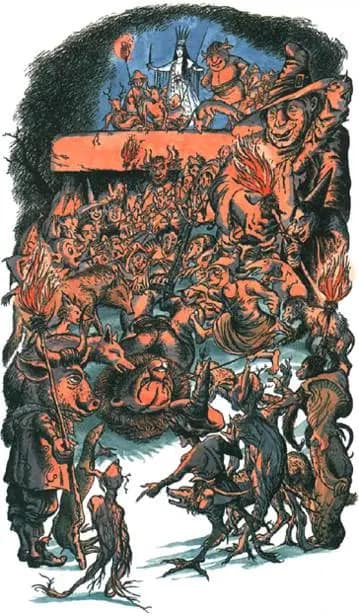I’ve never been able to get over the artwork in the original Chronicles of Narnia, particularly this image.
Lewis learned of the illustrator, Pauline Baynes, from his friend JRR Tolkien, who himself used her to illustrate Farmer Giles of Ham. She was young, relatively inexperienced, and felt understandably insufficient for the task. When Lewis sent her the manuscript for the first volume—The Lion, the Witch, and the Wardrobe—he included no instruction and left no clue as to any deeper meaning the stories might contain.
As she came to draw the White Witch tormenting and killing Aslan, she found herself stuck. Each time she neared completion of the drawing, she would be so grieved that her tears would stain and ruin the paper, forcing her to start over, again and again. Obviously, she was eventually able to complete the now classic illustrations and be done with the image, but the image wasn’t done with her.
For days afterwards, she found herself, like Aslan, tormented. She was haunted by this scene of evil binding and triumphing over good. Deliverance from her heavy cloud of depression came like a lightning strike, when she finally understood the words Aslan spoke after he came back to life:
“…though the Witch knew the Deep Magic, there is a magic deeper still which she did not know. Her knowledge goes back only to the dawn of Time. But if she could have looked a little further back, into the stillness and the darkness before Time dawned, she would have read there a different incantation. She would have known that when a willing victim who has committed no treachery was killed in a traitor’s stead, the Table would crack an Death itself would start working backwards.”
Aslan was the Lion of Judah, the lamb who was slain from the foundation of the world. Most of us approach the Chronicles with this typology in mind, but not Baynes. She, like the disciples on the road to Emmaus, had her heart strangely warmed when she realized that all Lewis had written, like Moses and the Prophets before him, was concerning the Messiah.
While the Chronicles of Narnia went on to be a massive success, selling over 100 million copies, both Lewis and Baynes lived extremely humble, modest lives. Because Lewis gave away the lion’s share (get it?!) of his royalties, he struggled to afford the taxes on an income he saw so little of. Baynes refused to negotiate a royalty deal for her work and instead illustrated each book for a flat fee of £100.
The Lewis oeuvre, particularly the fiction, has never been given the recognition it deserves from the intelligentsia, in Lewis’ day or ours. An exception came in 1957 when the Carnegie Medal was awarded to Lewis for his authorship of The Last Battle. When Baynes congratulated Lewis, he replied, “is it not really ‘our’ Medal?”
When I think of the nervous, tearful young lady who was given the impossible task of bringing Narnia to life, I think of young Caspian, who felt neither worthy nor ready to be king of Narnia.
“If you had felt yourself sufficient,” said Aslan, “it would have been a proof that you were not.”















This is one of the loveliest things I’ve read recently. Baynes’ illustrations have carried me along, and sometimes gripped me, from the first time I came across them in Farmer Giles of Ham. I’ve always wondered about her life, so was very pleased to have this small insight into her life.
I’d love to read more about her if you have any resources to recommend. Thank you!